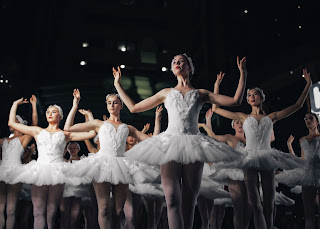Let's Talk about Inclusion and ...Tiny Pretty Things
So can we talk—about Tiny Pretty Things, now on Netflix, which I understand is based on the YA novel of the same name by Dhoniele Clayton and Sona Charaipotra about a group of ballet students at the fictional prestigious Archer School of Ballet?
We’ve been watching Tiny Pretty Things and each
episode reminds me more of the danger of the WOKE creating “inclusive” stories.
I suppose the ambition is worthy, even if the execution is appalling. It seems
as if the writers decided to achieve inclusion in this instance (and many
others but I’m only focusing on TPT here) by creating a check list of diverse types.
There, however, apparently can only be one of each type; this is, after
all, is a show set in the rarified world of privilege: white upper middle class,
skinny but toned students all of whom own evening clothes suitable for the
opera and the girls all wear coordinated Victoria’s Secret under things.
But I digress. The first challenge of allowing only one of
each demographic is that the writer then has to make that one character express the entire demographic; the character has to be all things to all people. Case in point, Naveah a
poor black girl from Compton (I guess her being from the Bronx would have been
too en pointe). Being the only black female in the cast, the writers have
indeed decided to make her all things to all people. Thus, Naveah is Mother
Teresa, Harriet Tubman, Rocky Balboa, and Norma Rae all rolled into one. At one
point another character actually calls her “Norma Rae.” I can’t decide if the writers
were winking at us knowingly at the inside joke; unfortunately, the laughter
comes at our expense.
And of course, Naveah has a positive, supportive brother in
a wheelchair who was—wait for it—shot in the spine by a cop. Because you know:
Black, poor, Compton.
There’s a young black male dancer who appears to be mixed
race (another box) though he is mostly defined by anger and an amorphous grief
caused by the unexplained death of his father.
Then, there is Shane, the one homosexual—I cannot bear to
refer to him as gay because as portrayed he is so unevolved—think Montgomery
MacNeil from the 1980s movie Fame, or any character from the original Boys
in the Band. In a stunning example of killing two birds with one stone,
Shane also checks off the box for trailer park trash, by his own
admission.
Shane is blond with many inches of black root. I can’t
decide if he abandoned being a blond because he ran out of money or interest.
His hair color is as undecided as the rest of him. Or maybe his hair color is a
metaphor for his sexuality: it burns a bright flame on the exterior, but the
root is black and decaying. The absurdity of there being one gay kid at a
ballet school is so obviously ridiculous that the ostensibly straight boy,
Oren, with whom Shane has been hooking up with says, “We’re in a ballet school;
there must be someone who wants to kiss you.”
“This, us, is enough for me,” Shane tells him. The exchange takes
place after Oren punches Shane in the face, by the way. We fought for equality for
decades to be portrayed like this?
Speaking of Oren, I assume he is meant to check off the box
for a character whose sexuality is fluid, since he is also sleeping with a female
ballet dancer who is also Shane’s dance partner in the big, dark number they are
rehearsing.
There is the Asian Tiger Mom—because of course there is—a
bitch in designer rags with a charm school walk and dead eyes. For good measure
she is a single mother, who made her own money after her parents, appalled she was
pregnant and unwed, disowned her. Asian? Check. Strong woman? Check.
The school's star pupil gets thrown from, falls over, or jumps off
the roof of the school’s dorm—at this point I don’t know which, nor do I much
care. The point is there is a comatose student and a roof is involved, yet the
roof remains accessible, with students running up there multiple times in every
episode to cry, talk, fume and in one chilling scene Shane, nearly naked dances
along the roof's edge.
Shane, oh Shane. He inappropriately admires a board member’s
husband telling him, “Your husband is such a pizza; everyone wants a slice.” The
board member stares at him mutely. We, too, are stunned into silence. Adults are
sleeping with underaged students; the school is covering up a possible
attempted murder. Mostly I’d be inclined to dismiss this and leave the white
people up to their senseless shenanigans but then they had to go and drag us into
this mess. And by “us” I mean anyone who is not skinny, rich and white, in
short, every one of their “diverse” characters who are meant to represent us.
So, what’s my point?
There are those of us who do this well. We write believable
diverse characters. Look us up. Read our books. By no means am I saying, you cannot
write characters not based on your lived experience or who don’t match your
identity. You can. And I admire the desire to be inclusive (assuming it’s not
just because you’ll sell more books and get Netflix to turn your novel into a
movie). I’m saying you can; you just can’t be lazy about it.
Throw that checklist away and approach your diverse
characters the way you approach your others. And include more than one.




Comments
Post a Comment